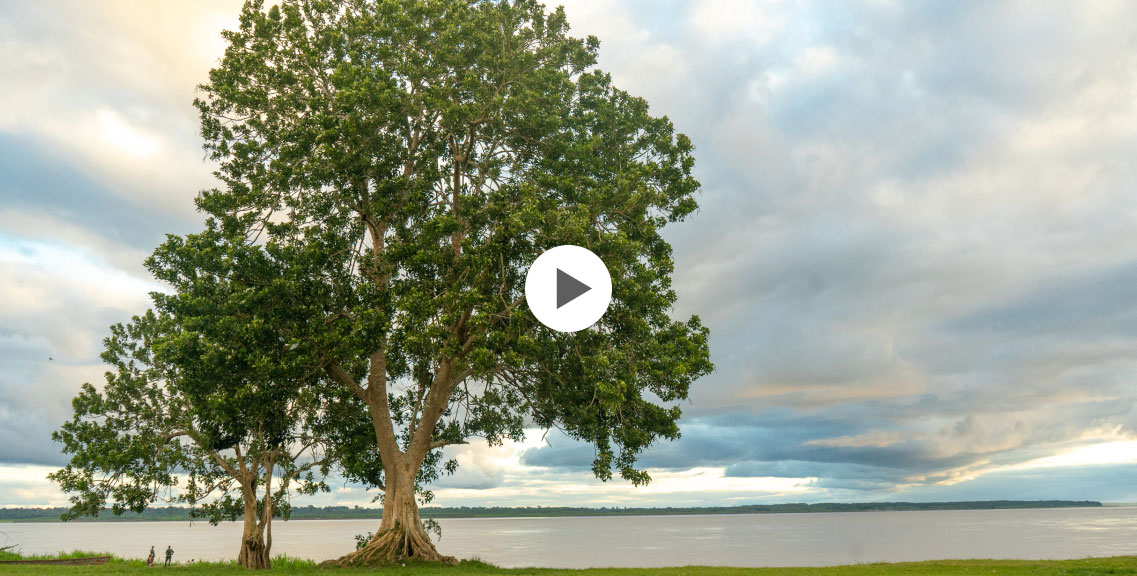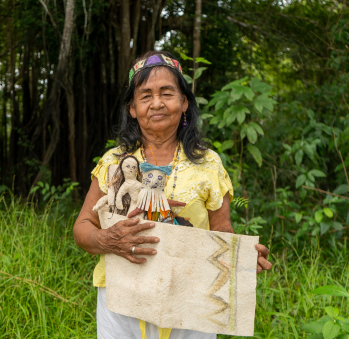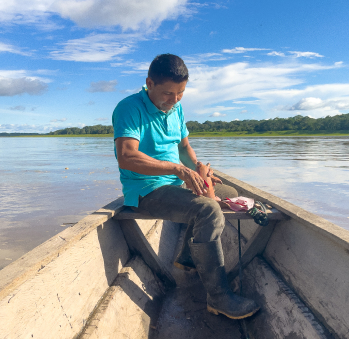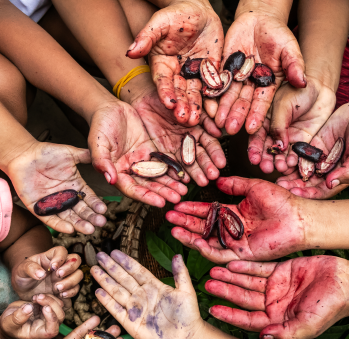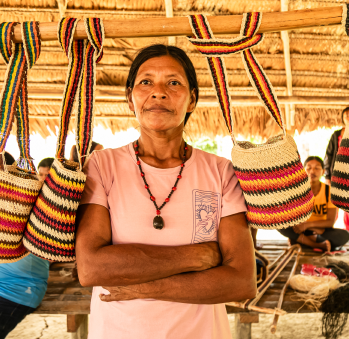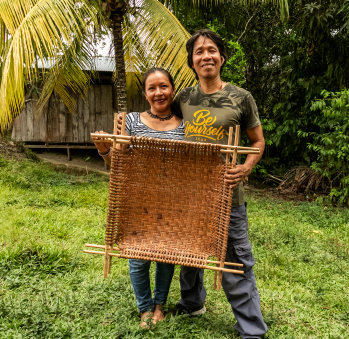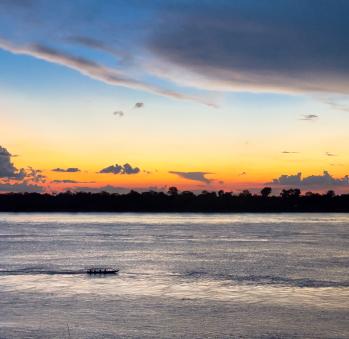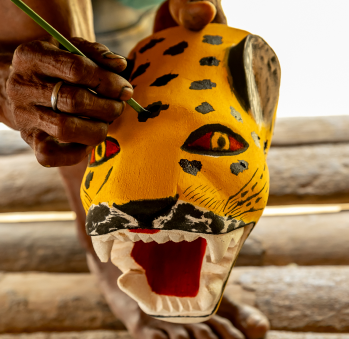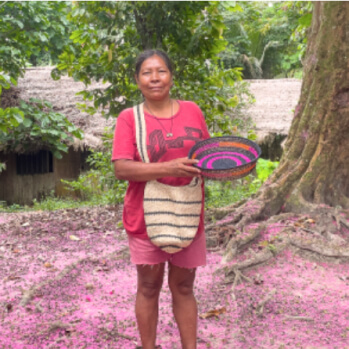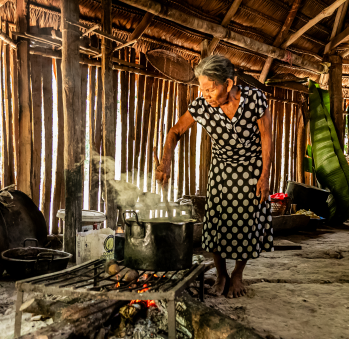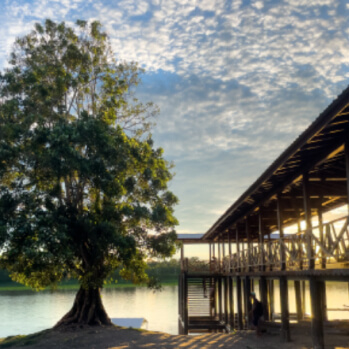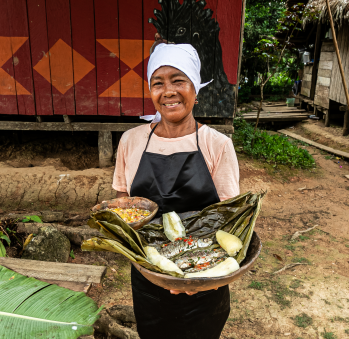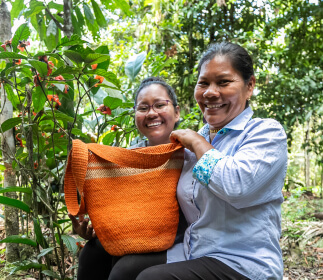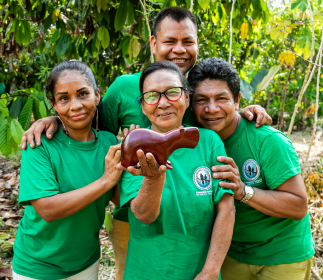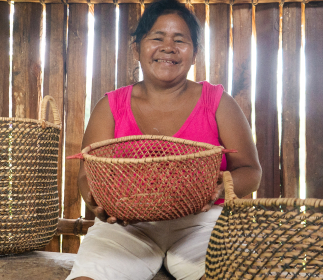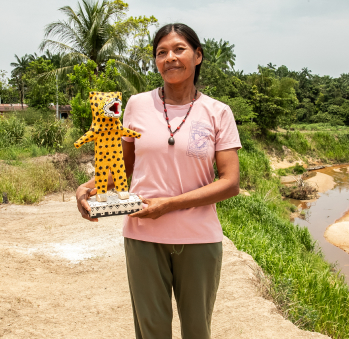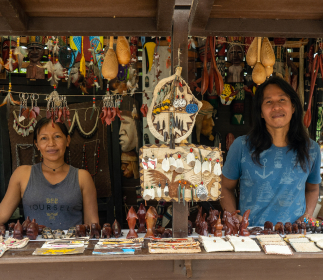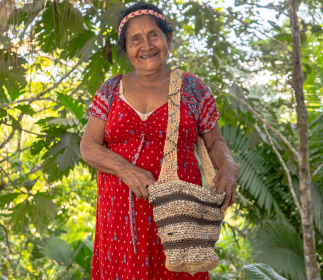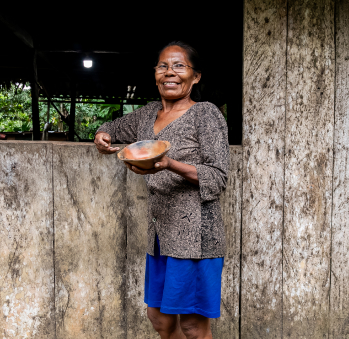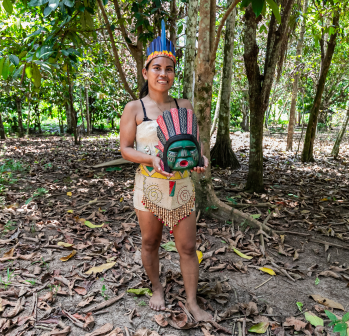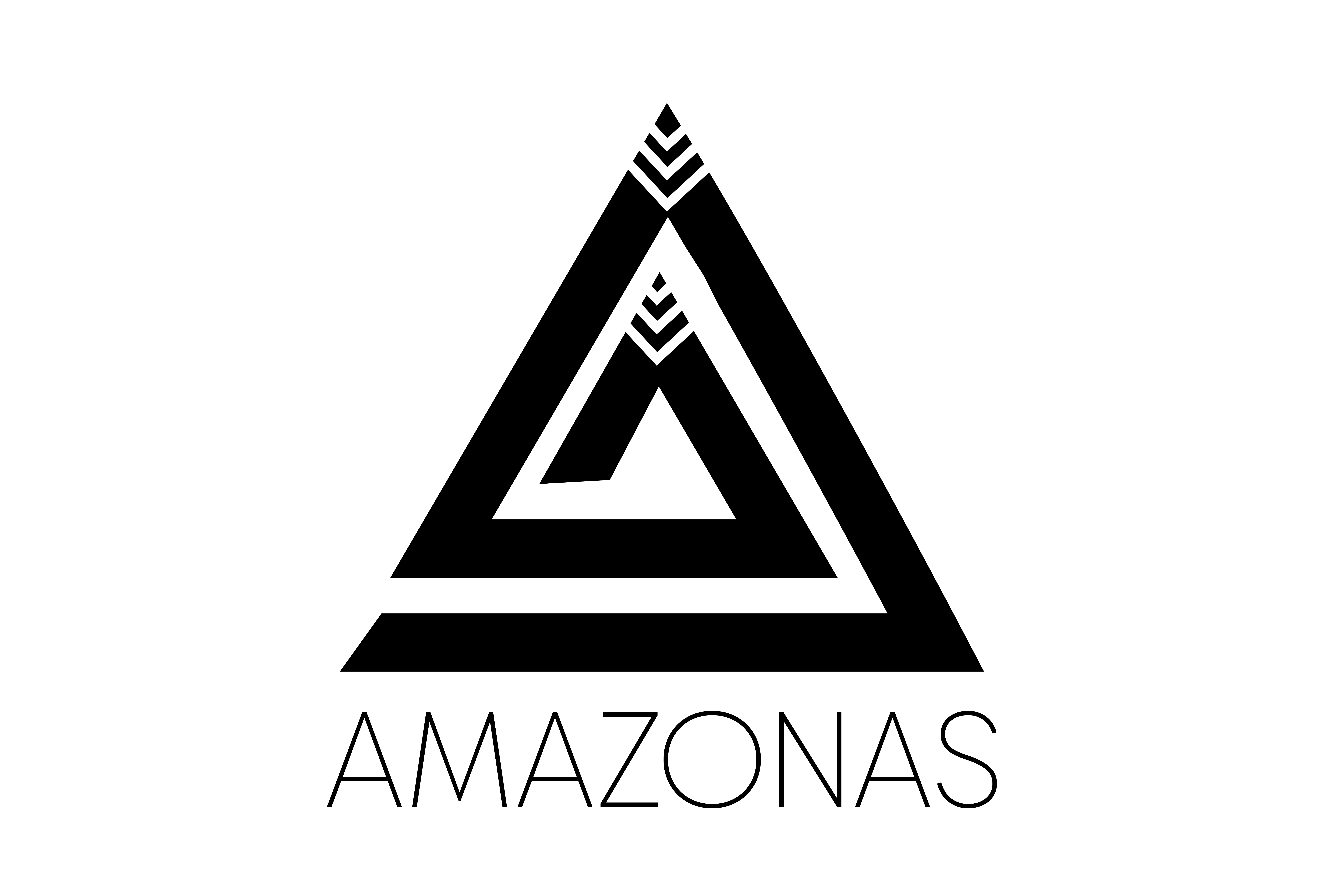Amazon Route
Entering the Amazon rainforest will always be stepping into a lush, indecipherable, and magical place. It is the home of the gigantic Amazon River and its thousand exuberant arms, which are as wide as they are sweet and embracing. The region is emblematic for the landscapes of trees that go up to the sky, the infinite sounds of nature that fill the air, the humid heat alleviated by the green shade and the wet earth, and the proximity to the country of Brazil. This is the land of the Tikuna, Huitoto, Bora, Yukuna, Miraña, Tanimuka, Murú, and Muinane people. It is the birthplace of skillful carvers of bloodwood, old fustic — also called macacauba— trees, and balsa or genip wood. It is also the home of expert weavers who craft their baskets with chambira palm and make dolls in a fabric made from yanchama tree fibers. Amazonas’s craftspeople also specialize in colorful necklaces and bracelets that they fashion with the seeds of the region’s fruits. This trail offers a journey that mixes distinct river and city experiences. It goes along a series of interesting settlements that blend together urban and forest life. It is fascinating to watch how the indigenous communities that inhabit these settlements experience their traditions. Their hands invite us to discover the power of their cosmogonies.
Embark on a journey full of history
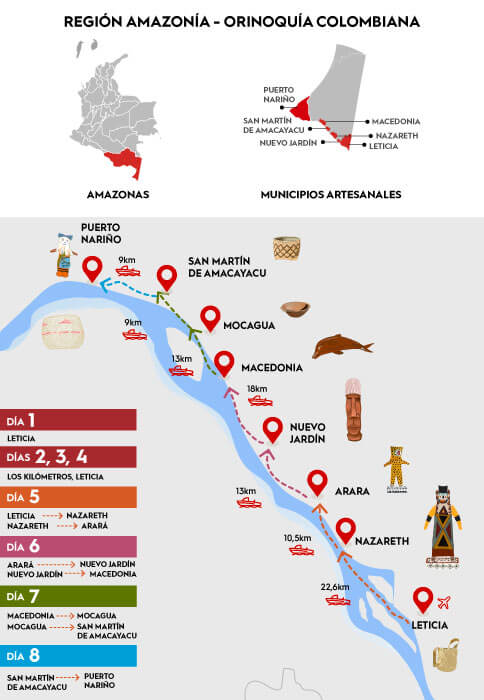
Artisans along the way
Artisans along the way
We recommended this tour
Schedule the visit in advance with the artisans.
Carry cash.
Carry marsh boots.
Carry mosquito repellent.
Carry a backpack.
Carry hydration.
Wear long-sleeved shirts and pants.
Carry a flashlight.
Have yellow fever vaccine 10 days prior to travel.
Food (lunch and snacks), plan with the artisans if it is possible to purchase lunch from them.
Preferably go with the tour operator
Be aware of boat schedules to organize your travels
4-5 days
Medium (long walks in rainforests)
Boat
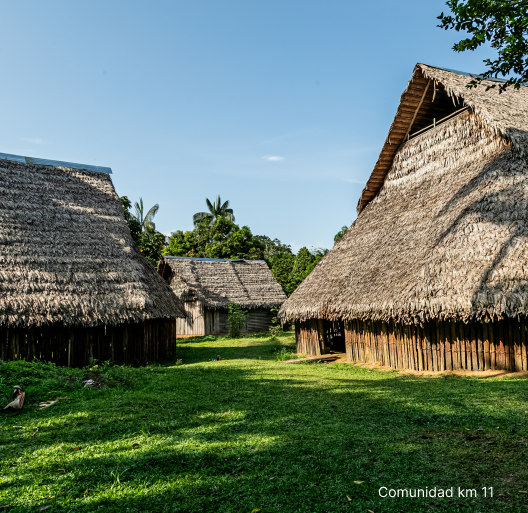
Leticia
We start this tour in Leticia, the Amazonian capital that has sheltered the indigenous communities forced to leave the forest for different reasons. Their ability to plant chagras in an urban landscape is surprising, as well as their resistance when maintaining their customs and trades. Don’t miss Santander Park, also known as Parrot Park, with several species of parrots and thousands of white-feathered parakeets, as well as migratory swallows between February and October. Going in the afternoon is important because that’s when they come to roost, leaving this shelter in the early morning. You can visit Milena Vento and her husband James Marín in the Simón Bolívar neighborhood, where they have their workshop. Milena is also a guide at the Amazonian Ethnographic Museum, which is part of the Banco de la República’s Public Library, and it’s worth a visit. You can schedule a visit to Nuevo Jardín with her, where her parents are from, which is half an hour away by speedboat. There, you can discover how the yanchama fiber is extracted. You can also go to Barrio Nuevo to visit Karine Dinorio, heir of the founders of Macedonia, and to the Chingú community, which is on the border with Brazil, about 35 minutes from the urban center, to meet Tráncito Rodríguez. Toward the outskirts of Leticia, there are several nature reserves offering responsible tourism activities that contribute to the communities’ wellbeing.
LOS KILÓMETROS
We continue to this area known as Los Kilómeteros, which are semi-rural settlements that the indigenous communities have gradually founded at Km. 6, Km. 11, and Km. 22. These settlements are as close to the city as they are to their forest, where they have been able to build their malocas (round huts) and worship the cassava and manioc, which is the basis of their diet, as well as the hundreds of fruits they use for their rituals. You can easily reach these workshops by bus and prepare for a journey into the rainforest, walking toward the indigenous reserves. You’ll find Chunaki Baru at Km 6; and in Km 8, also known as San Pedro de los Lagos, visit Deisy Sánchez (don’t miss the nearby natural pools). At Km 11, meet Kasia Morales and her family; and at Kilometer 22, in Cihtacoyd, the Community of the Indigenous Council of the Tobacco, Coca and Cassava Heirs, you’ll find the home of Rosa Amelia Meicuaco. This settlement is home to seven different indigenous cultures. It will be possible for you to learn from them the traditions and festivities they like to share. You can immerse yourself in their culture respectfully following their beliefs and witnessing their dances. This experience is a true privilege. Dedicate an entire day to this point and start very early, for, in order to access Los Kilómetros, you must first ride a motorcycle cab for 40 minutes and then walk 45 more minutes until you reach the village. The idea is for you to program a day so you get to know in detail the way in which wares are crafted, go to the chagra, walk through the trail where raw materials are gathered, take place in a workshop, and have lunch there.
Nazareth, Arara, Nuevo Jardin y Macedonia
At this point in the journey, you will discover the river, travel down through it, and admire the riverside life of different communities. One of these is Nazareth (22 kilometers away from Leticia). Here, you can bear witness to the ritual of the girls’ confinement, customary right after they hit puberty, or schedule one of the unmissable Tikuna cumbia and dancing sessions. This is the home of the weaver Credi Pereira, who with great eloquence will share the secrets of the chinchorro hammock. Take into account that moving through the river means having to follow the boats’ schedules (there is a departure fee and another pick-up fee slightly costlier than the former). You can also get there by land walking through a trail, which is an invitation to observe nature. Give this first settlement at least half a day. Then head to the Arara community, where Antonila Ramos and her people will welcome you. Continuing along the river, stop at Nuevo Jardín, where you can try the delicious plantain mazamorra offered by James Marín before watching him carve and seeing Milena and her parents weaving. The next stop is Macedonia, a 90-minute boat ride from Leticia, where carvers have made the palo sangre wood famous. This is a must-see stop to watch the finest masters at work (note that there are only three fast boat rides per day; you can also take smaller boats, known as peque peque, which you can hire for more autonomy. Be sure to negotiate the price before you set off). Consider spending the night here or in the nearby village of Mocagua.
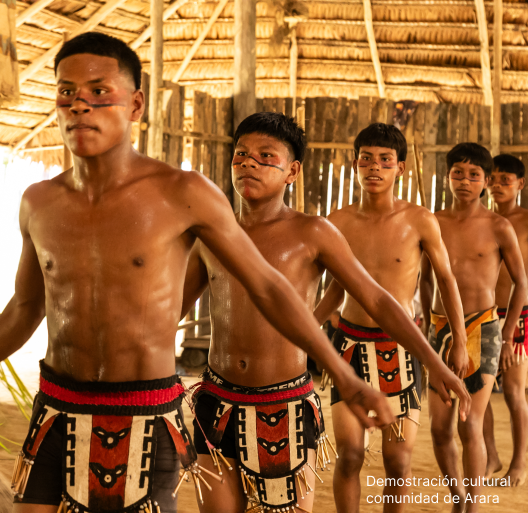
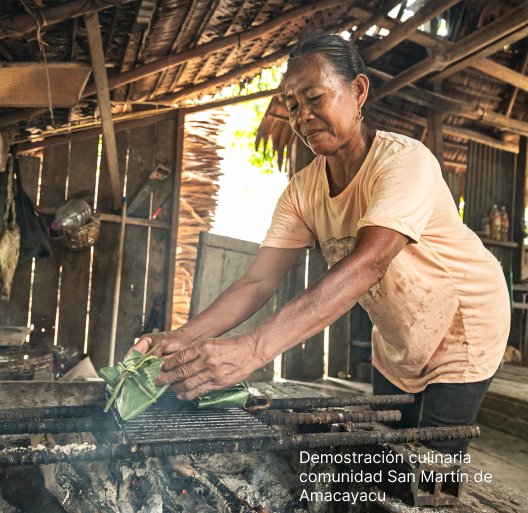
Mocagua, San Martín de Amacaytacu and Puerto Narino
This village is truly special. The community has a deep connection to its land, and thanks to the help of Diego Samper, a local artist and owner of the renowned Calanoa Hotel, all the houses are painted with nature motifs. In Mocagua, you’ll meet Matilde Santos, one of the few potters in the Amazon, and a true master. You can spend the night here comfortably. From there, head to the San Martín de Amacayacu reserve, home to artisans Magri Lorena Morán and her grandmother Grimanesa, both dedicated to preserving their legacy. Finally, make your way to Puerto Nariño, the last village on the river, where you can also spend the night. It is a refuge whose inhabitants have fervently protected from pollution. They have preserved their surrounding bits of river and rainforest intact. Here, you will also be able to see the pink river dolphins. In this settlement, you will meet some of the region’s most experienced weavers, such as Alba Lucía Cuéllar and Pastora Guerrero.With them you will be able to learn to weave, go to their workshops, go with them to their chagras and the places where they harvest yanchama and chambira. Do not miss out on the Tarapoto Lake, deservedly declared a world heritage site for its splendour (it is 15 minutes away by boat).
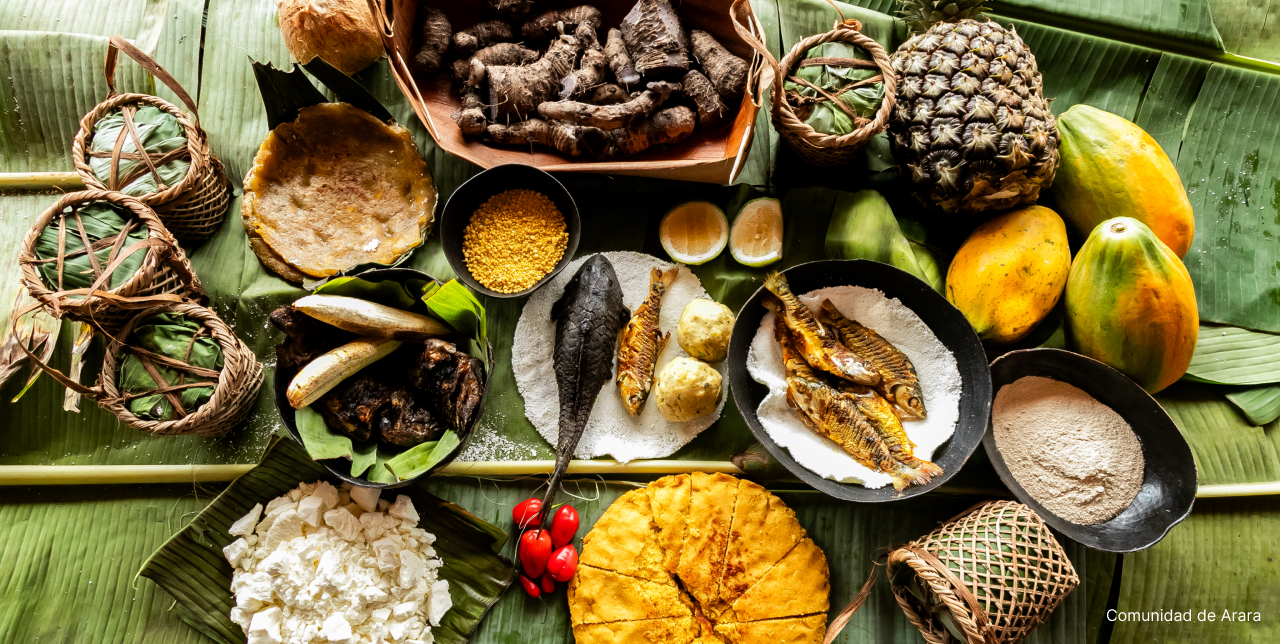
Traditional cuisine
and typical bites
Provoke yourself
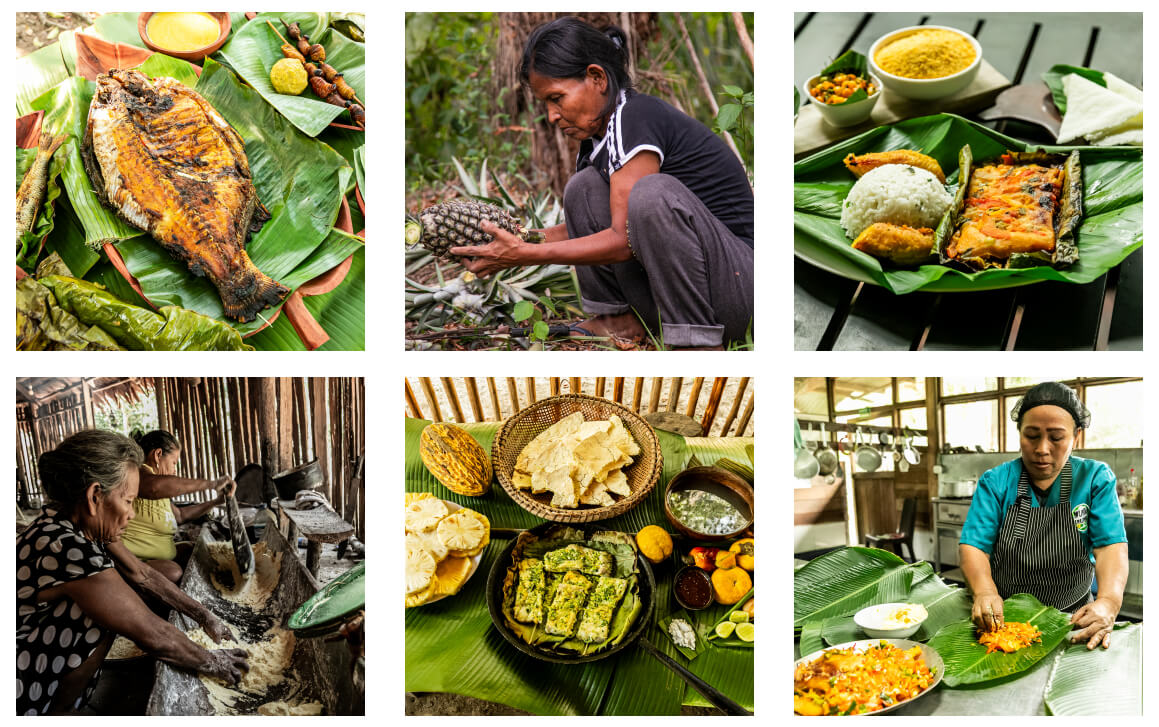
Don't leave without eating this 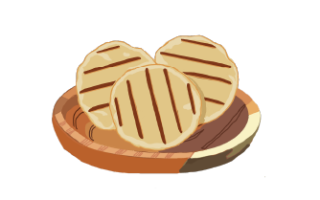
Another essential ingredient in the Amazonian diet is yuca (cassava). This root vegetable is native to the region, with many varieties. The Indigenous communities of the Amazon cultivate two main types: sweet yuca and bitter yuca. Sweet yuca is white, cooks easily, and is typically served as a side dish, while bitter yuca has a yellowish hue, a thick skin, and is tough, requiring longer cooking times. Bitter yuca also contains a toxin, but Indigenous people have developed an ancient process to make it safe to eat. This process transforms it into the base for dishes like casabe, tucupí, and chicha—all fundamental flavors in this vast region.
At km 11, you can visit the maloca of Kasia González, a member of the Murui community. She offers wellness and gastronomic tourism, where you can immerse yourself in Amazonian culture, customs, and traditions. In the early morning, they head to their chagras to harvest the bitter yuca, which is their main food source. After soaking it in water for two or three days to allow fermentation and remove the toxins, they press it using a sebucán or tipití—a woven basket that extracts the poisonous juices. From the starch, they make casabe, and the remaining pulp is dried in the sun to prepare fariña or farofa (a flour-like dish). Tucupí is a sauce made from the juice of the yuca, mixed with ants and other spices, creating a thick, slightly spicy treat that pairs perfectly with casabe and regional fish. Sweet yuca is usually boiled or roasted and accompanies many dishes. You can find these preparations in several communities on the recommended tour, such as San Martín de Amacacayu with Magri Lorena, Arara with Antonila Ramos, San Pedro de los Lagos with Deisy Sánchez, Nuevo Jardín with Milena Vento and James Marín, and at km 6 with the Asociación Artesanal Chunaki Barú.
Also popular are the pirarucú fish chicharrones. At Flotante Balsa El Pirarucú restaurant, you can enjoy dishes featuring this delicious fish. The restaurant’s base is in Leticia, but it can navigate up the Amazon River, offering guests the chance to enjoy great food while taking in the stunning landscape. These dishes are often served with yuca.
Another common fish in the Amazon diet is piranha, which is often grilled, stewed, or boiled. The Bar Restaurante Tierras Amazónicas in Leticia serves this succulent fish.
To lunch we go 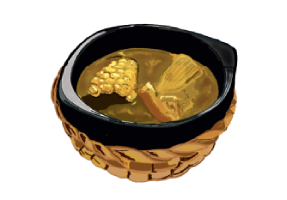
Fish will always be the best option in the Amazon region. One signature dish is Patarashka (or patarasca). Made with gamitana (a type of fish similar to cachama) or pirarucú, the fish is wrapped in banana leaves with salt, tucupí, and cooked over an open fire, accompanied by boiled yuca, plantains, and casabe. Another favorite is Cachama al mojo de ajo—a grilled fish cooked on banana leaves with garlic sauce, served with casabe, green plantain, and tucupí sauce. At Mundo Amazónico, you can enjoy these dishes in a family-friendly atmosphere, surrounded by nature.
Tacacho with Cecina meat is a popular dish among locals near the Amazon River. It’s a mashed green plantain dish, seasoned with native onions and garlic, topped with dried and salted meat, which can come from wild animals or cattle. The meat is preserved by dehydration, perfect for long river journeys. You can try this dish at El Rancho restaurant in Leticia.
Flavors to discover and snack on 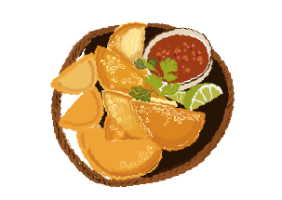
One unique Amazonian delicacy is mojojoy, a local treat prized by Indigenous communities. For visitors, it’s an unforgettable experience, as mojojoy consists of large, edible larvae that are high in calories and free of cholesterol. Once you get past their appearance, you’ll discover they have a wood-like taste. They’re typically roasted, fried, or stuffed. Mundo Amazónico restaurant in Leticia offers this exotic dish, subject to availability of the larvae. You can also arrange to try them at some of the artisan workshops we recommend, especially with the Asociación Artesanal Chunaki Barú at km 6 on the Leticia-Tarapaca road.
To sweeten the palate and unmissable drinks 
Tapioca is one of the Amazon’s specialties, made from yuca starch. The tapioca is soaked in hot water, strained after about half an hour, and then sweetened with fruit syrup to taste. It becomes one of the region’s most popular desserts, loved by both tourists and locals. You can find it in various places we’ve mentioned, though it’s not always available or featured on the menu.
Amazonian fruit sweets, such as those made from araza, carambolo (star fruit), and marañón (cashew), are commonly found at local markets (such as the Leticia Market) and in local homes.
In the Amazon, as in many regions of Colombia, fermented beverages known as chichas are popular. In the Amazon, these drinks are made by fermenting fruits like chontaduro (peach palm) or pineapple for several days, or by fermenting fariña. Chive is made by mixing fruit pulp with fariña dissolved in water.
You can also enjoy refreshing fruit waters made from tropical fruits like araza, camu camu, copoazú, and açaí, which may or may not contain added sugar. These drinks are common in both restaurants and local homes throughout the Amazon region. Deisy Sánchez from San Pedro de los Lagos prepares delicious, refreshing beverages with these exotic fruits.
Recommended sites

Pueblo Patrimonio
La Red Turística de Pueblos Patrimonio de Colombia es un programa especial del Ministerio de Comercio, Industria y Turismo, ejecutado por FONTUR, que trabaja con 17 municipios de Colombia que poseen declaratoria de Bien de Interés Cultural (BIC) a nivel nacional para su valoración y proyección mediante el turismo, generando así más oportunidades de desarrollo y sostenibilidad en las comunidades.

La Medalla a la Maestría Artesanal es un galardón que Artesanías de Colombia entrega anualmente, con el cual se hace un reconocimiento a aquellos artesanos, empresas y comunidades artesanales que, contando con una trayectoria destacada, sobresalen a nivel nacional por su excelencia en el oficio así como por preservar el quehacer artesanal.

Denominación de Origen
Es un signo distintivo que identifica productos reconocidos o famosos por tener una calidad o características específicas derivadas esencialmente del lugar de origen y la forma tradicional de extracción, elaboración y producción por parte de sus habitantes. La protección conferida sobre una Denominación de Origen implica que ninguna persona puede identificar con la denominación protegida productos iguales o similares a los amparados, cuando no provengan del verdadero lugar y no cumplan con las características o calidades que le han dado la reputación al producto reconocido. Las Denominaciones de Origen para productos artesanales colombianos que han sido protegidas por la Superintendencia de Industria y Comercio en nuestro país son actualmente 12.
No puede copiar contenido de esta página








































